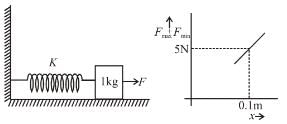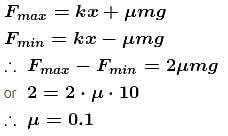Physics Exam > Physics Questions > A block of mass 1 kg is placed on a rough hor...
Start Learning for Free
A block of mass 1 kg is placed on a rough horizontal surface. A spring is attached to the block whose other end is joined to a rigid wall, as shown in the figure. A horizontal force is applied on the block so that it remains at rest while the spring is elongated by x.  Let Fmax and Fmin be the maximum and minimum value of force F for which the block remains in equilibrium.
Let Fmax and Fmin be the maximum and minimum value of force F for which the block remains in equilibrium.
For a particular x, Fmax – Fmin = 2N. Also shown is the variation of Fmax + Fmin versus x, the elongation of the spring.
 Let Fmax and Fmin be the maximum and minimum value of force F for which the block remains in equilibrium.
Let Fmax and Fmin be the maximum and minimum value of force F for which the block remains in equilibrium.For a particular x, Fmax – Fmin = 2N. Also shown is the variation of Fmax + Fmin versus x, the elongation of the spring.

The coefficient of friction between the block and the horizontal surface is :
Correct answer is '0.1'. Can you explain this answer?
| FREE This question is part of | Download PDF Attempt this Test |
Verified Answer
A block of mass 1 kg is placed on a rough horizontal surface. A spring...

The correct answer is: 0.1
Most Upvoted Answer
A block of mass 1 kg is placed on a rough horizontal surface. A spring...

The correct answer is: 0.1

|
Explore Courses for Physics exam
|

|
Similar Physics Doubts
A block of mass 1 kg is placed on a rough horizontal surface. A spring is attached to the block whose other end is joined to a rigid wall, as shown in the figure. A horizontal force is applied on the block so that it remains at rest while the spring is elongated byx.LetFmaxandFminbe the maximum and minimum value of forceFfor which the block remains in equilibrium.For a particularx,Fmax–Fmin= 2N. Also shown is the variation ofFmax+Fminversusx, the elongation of the spring.The coefficient of friction between the block and the horizontal surface is :Correct answer is '0.1'. Can you explain this answer?
Question Description
A block of mass 1 kg is placed on a rough horizontal surface. A spring is attached to the block whose other end is joined to a rigid wall, as shown in the figure. A horizontal force is applied on the block so that it remains at rest while the spring is elongated byx.LetFmaxandFminbe the maximum and minimum value of forceFfor which the block remains in equilibrium.For a particularx,Fmax–Fmin= 2N. Also shown is the variation ofFmax+Fminversusx, the elongation of the spring.The coefficient of friction between the block and the horizontal surface is :Correct answer is '0.1'. Can you explain this answer? for Physics 2024 is part of Physics preparation. The Question and answers have been prepared according to the Physics exam syllabus. Information about A block of mass 1 kg is placed on a rough horizontal surface. A spring is attached to the block whose other end is joined to a rigid wall, as shown in the figure. A horizontal force is applied on the block so that it remains at rest while the spring is elongated byx.LetFmaxandFminbe the maximum and minimum value of forceFfor which the block remains in equilibrium.For a particularx,Fmax–Fmin= 2N. Also shown is the variation ofFmax+Fminversusx, the elongation of the spring.The coefficient of friction between the block and the horizontal surface is :Correct answer is '0.1'. Can you explain this answer? covers all topics & solutions for Physics 2024 Exam. Find important definitions, questions, meanings, examples, exercises and tests below for A block of mass 1 kg is placed on a rough horizontal surface. A spring is attached to the block whose other end is joined to a rigid wall, as shown in the figure. A horizontal force is applied on the block so that it remains at rest while the spring is elongated byx.LetFmaxandFminbe the maximum and minimum value of forceFfor which the block remains in equilibrium.For a particularx,Fmax–Fmin= 2N. Also shown is the variation ofFmax+Fminversusx, the elongation of the spring.The coefficient of friction between the block and the horizontal surface is :Correct answer is '0.1'. Can you explain this answer?.
A block of mass 1 kg is placed on a rough horizontal surface. A spring is attached to the block whose other end is joined to a rigid wall, as shown in the figure. A horizontal force is applied on the block so that it remains at rest while the spring is elongated byx.LetFmaxandFminbe the maximum and minimum value of forceFfor which the block remains in equilibrium.For a particularx,Fmax–Fmin= 2N. Also shown is the variation ofFmax+Fminversusx, the elongation of the spring.The coefficient of friction between the block and the horizontal surface is :Correct answer is '0.1'. Can you explain this answer? for Physics 2024 is part of Physics preparation. The Question and answers have been prepared according to the Physics exam syllabus. Information about A block of mass 1 kg is placed on a rough horizontal surface. A spring is attached to the block whose other end is joined to a rigid wall, as shown in the figure. A horizontal force is applied on the block so that it remains at rest while the spring is elongated byx.LetFmaxandFminbe the maximum and minimum value of forceFfor which the block remains in equilibrium.For a particularx,Fmax–Fmin= 2N. Also shown is the variation ofFmax+Fminversusx, the elongation of the spring.The coefficient of friction between the block and the horizontal surface is :Correct answer is '0.1'. Can you explain this answer? covers all topics & solutions for Physics 2024 Exam. Find important definitions, questions, meanings, examples, exercises and tests below for A block of mass 1 kg is placed on a rough horizontal surface. A spring is attached to the block whose other end is joined to a rigid wall, as shown in the figure. A horizontal force is applied on the block so that it remains at rest while the spring is elongated byx.LetFmaxandFminbe the maximum and minimum value of forceFfor which the block remains in equilibrium.For a particularx,Fmax–Fmin= 2N. Also shown is the variation ofFmax+Fminversusx, the elongation of the spring.The coefficient of friction between the block and the horizontal surface is :Correct answer is '0.1'. Can you explain this answer?.
Solutions for A block of mass 1 kg is placed on a rough horizontal surface. A spring is attached to the block whose other end is joined to a rigid wall, as shown in the figure. A horizontal force is applied on the block so that it remains at rest while the spring is elongated byx.LetFmaxandFminbe the maximum and minimum value of forceFfor which the block remains in equilibrium.For a particularx,Fmax–Fmin= 2N. Also shown is the variation ofFmax+Fminversusx, the elongation of the spring.The coefficient of friction between the block and the horizontal surface is :Correct answer is '0.1'. Can you explain this answer? in English & in Hindi are available as part of our courses for Physics.
Download more important topics, notes, lectures and mock test series for Physics Exam by signing up for free.
Here you can find the meaning of A block of mass 1 kg is placed on a rough horizontal surface. A spring is attached to the block whose other end is joined to a rigid wall, as shown in the figure. A horizontal force is applied on the block so that it remains at rest while the spring is elongated byx.LetFmaxandFminbe the maximum and minimum value of forceFfor which the block remains in equilibrium.For a particularx,Fmax–Fmin= 2N. Also shown is the variation ofFmax+Fminversusx, the elongation of the spring.The coefficient of friction between the block and the horizontal surface is :Correct answer is '0.1'. Can you explain this answer? defined & explained in the simplest way possible. Besides giving the explanation of
A block of mass 1 kg is placed on a rough horizontal surface. A spring is attached to the block whose other end is joined to a rigid wall, as shown in the figure. A horizontal force is applied on the block so that it remains at rest while the spring is elongated byx.LetFmaxandFminbe the maximum and minimum value of forceFfor which the block remains in equilibrium.For a particularx,Fmax–Fmin= 2N. Also shown is the variation ofFmax+Fminversusx, the elongation of the spring.The coefficient of friction between the block and the horizontal surface is :Correct answer is '0.1'. Can you explain this answer?, a detailed solution for A block of mass 1 kg is placed on a rough horizontal surface. A spring is attached to the block whose other end is joined to a rigid wall, as shown in the figure. A horizontal force is applied on the block so that it remains at rest while the spring is elongated byx.LetFmaxandFminbe the maximum and minimum value of forceFfor which the block remains in equilibrium.For a particularx,Fmax–Fmin= 2N. Also shown is the variation ofFmax+Fminversusx, the elongation of the spring.The coefficient of friction between the block and the horizontal surface is :Correct answer is '0.1'. Can you explain this answer? has been provided alongside types of A block of mass 1 kg is placed on a rough horizontal surface. A spring is attached to the block whose other end is joined to a rigid wall, as shown in the figure. A horizontal force is applied on the block so that it remains at rest while the spring is elongated byx.LetFmaxandFminbe the maximum and minimum value of forceFfor which the block remains in equilibrium.For a particularx,Fmax–Fmin= 2N. Also shown is the variation ofFmax+Fminversusx, the elongation of the spring.The coefficient of friction between the block and the horizontal surface is :Correct answer is '0.1'. Can you explain this answer? theory, EduRev gives you an
ample number of questions to practice A block of mass 1 kg is placed on a rough horizontal surface. A spring is attached to the block whose other end is joined to a rigid wall, as shown in the figure. A horizontal force is applied on the block so that it remains at rest while the spring is elongated byx.LetFmaxandFminbe the maximum and minimum value of forceFfor which the block remains in equilibrium.For a particularx,Fmax–Fmin= 2N. Also shown is the variation ofFmax+Fminversusx, the elongation of the spring.The coefficient of friction between the block and the horizontal surface is :Correct answer is '0.1'. Can you explain this answer? tests, examples and also practice Physics tests.

|
Explore Courses for Physics exam
|

|
Suggested Free Tests
Signup for Free!
Signup to see your scores go up within 7 days! Learn & Practice with 1000+ FREE Notes, Videos & Tests.


















